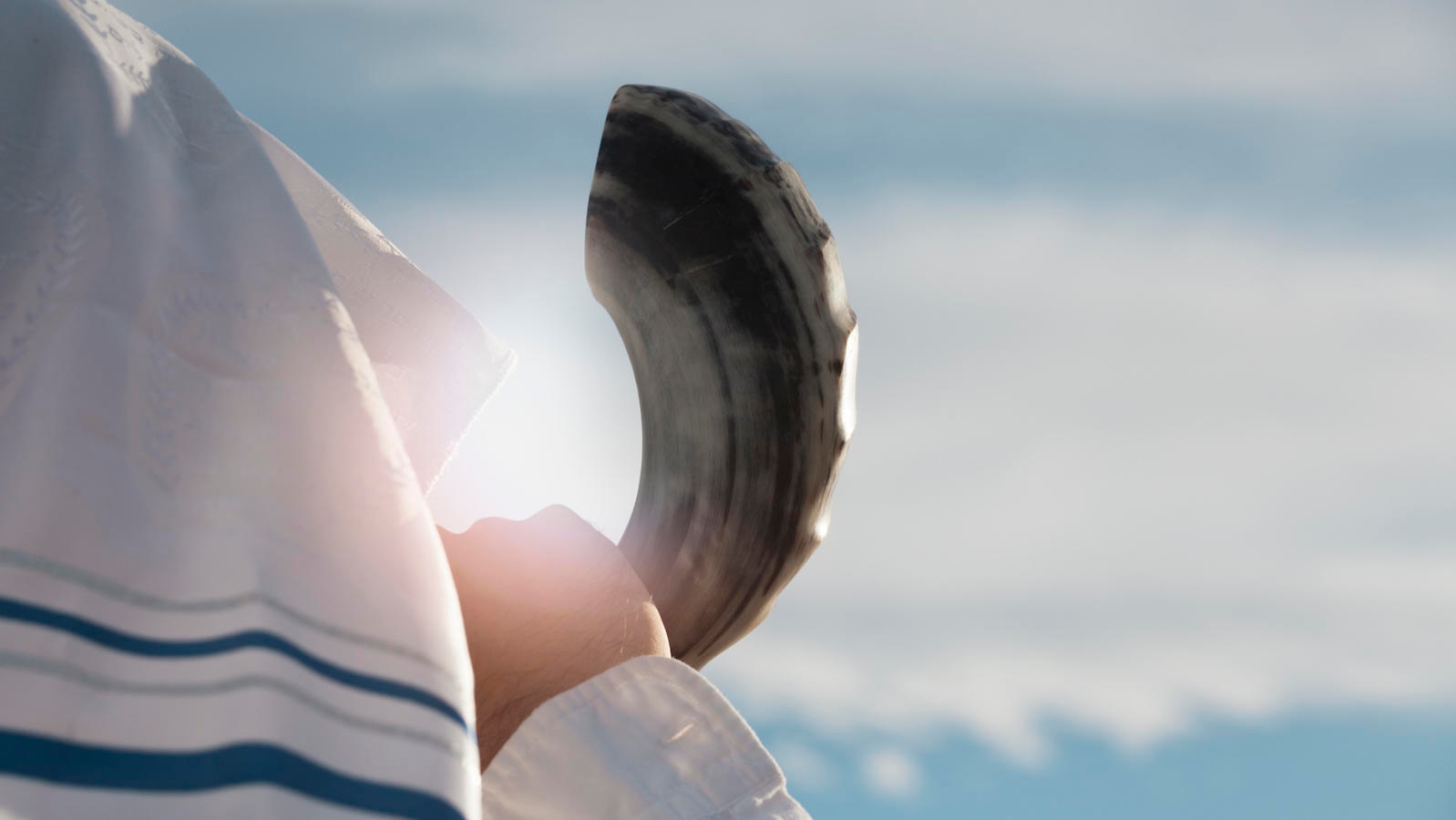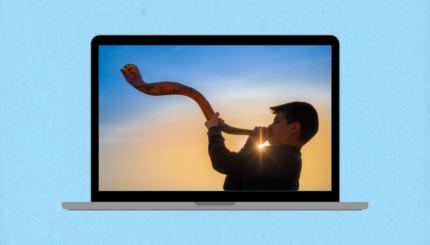And when Elijah heard it, he wrapped his face in his mantle and went out, and stood in the entrance to the cave. And behold there came to him a voice and said: ‘What are you doing here, Elijah?’ (1 Kings 19:12-13)
One of my colleagues had the custom of holding up his shofar to show that it was in the shape of a question mark. I often blow the shofar on Rosh Hashanah, but mine would have to be twisted considerably before it would look the same. Still, I agree that the shofar presents a question.
This is true even at the most basic level. If one strikes the keyboard of a piano, it produces a note. But if one blows into the shofar–even though one has some skill and has blown successfully on a dozen previous occasions–there is always a doubt. Responding to the atmosphere in the synagogue, or the spirit of the service, or some hidden facet of the blower’s state of being, the shofar may simply refuse to produce any sound at all. There is always a mystery, always a question.
Hearing the Sound
To whom is this question addressed? Jewish law provides a clear answer. Everyone has to hear the sound of the shofar. The very blessing that the blower recites tells us that the commandment is not to make, but to listen to, the sound. Just to overhear it is not enough. If one passes a building and happens to catch the sound of the notes, that is not considered proper listening. There has to be a partnership between blower and hearer, a shared attentiveness. For the shofar addresses each person individually. Its question cannot be heard by proxy or by the outer ear only; we have to listen to it in the fullness of our own being.
With your help, My Jewish Learning can provide endless opportunities for learning, connection and discovery.
What is the shofar’s question? There is an important clue in the story of Elijah, who journeyed for 40 days to reach the mountain of the Lord and entered the very same cave where God was revealed to Moses. There he heard the terrifying sounds of earthquakes, fire, and thunder. But they left him unmoved; he remained in his cave. When, however, he heard the voice of fine silence, he was struck by awe and understood that this was a summons he had to answer. Covering his face with his mantle, he came out to confront the ultimate question, “What are you doing here, Elijah?”
That same sound of fine silence is likened in the liturgy to the voice of the shofar, as it says: “The great shofar will be blown, and the voice of fine silence will be heard.” So the question of the shofar is simply: What are we doing here, you and I? It is addressed to each of us and pursues us all our lives.
Multi-Faceted Question
The question is first and foremost a personal one. Its tone varies; it need not always be serious. On the way back from synagogue the other day my son got stuck between a lamppost and a fence, and the inquiry, “What are you doing there, Mossy?” had a quality with which every parent will be familiar. But as we get older, the issues become more pressing. In loneliness, in indecision, amidst trivial routines, the question, “What am I doing here?” penetrates the most intimate regions of self-doubt and despair with the power to evoke a seemingly irresolvable anguish.
Yet there are also moments of joy–at night in the streets or in a garden, looking at the blue-black sky, hearing a late bird call sharply out–when the feeling, “What a privilege it is to be here!” and the questions, “What can I do and what can I give?” traverse the mind like a blessing.
Even at the close of life the shofar’s question follows us. I remember a wedding for which the date was put forward because the groom’s father was terminally ill. On the clay itself he found a special strength, and the celebration was marked by a particular tenderness and joy. However, I was not surprised to receive a phone call 24 hours later telling me that he was dying. To my surprise, he wanted me to come and see him. By the time I got there, he could hardly talk. I leaned close to him, and he asked me, “What do I have to do now?” The question was pursuing him even then. He needed to hear that he had fulfilled his responsibilities on earrh with dignity and love and that he was free to go in peace.
Thus the shofar’s question, “What are you doing here?” follows us in our innermost being and until our final breath. But the shofar is also a specifically Jewish instrument, and its sound traverses Jewish history. The ram’s horn recalls the binding of Isaac and God’s covenant with Abraham. It reminds us of the giving of the Torah at Mount Sinai, when the Jewish people entered into a bond with God. The shofar was to be blown every 50th year, to proclaim freedom to all the inhabitants of the land of Israel. And at the end of days, when the exiles are gathered in, “…a great shofar shall be sounded and those lost in the land of Assyria and cast away in the land of Egypt shall come and worship the Lord on the holy mountain in Jerusalem” (Isaiah 27:13).
Binding of Isaac
Of these connections with history it is the association with the binding of Isaac that is most important on Rosh Hashanah. It is as if by blowing a ram’s horn we are specifically reminding God of all that the Jewish people have sacrificed throughout the ages, in a protest and a declaration: “See what we have given for the sake of our relationship with you, God. Remember your side of the partnership and protect us with your love.”
These themes, sacrifice and tenderness, were brought home to me in picture by Ernest Neushul, which I saw at the house of a friend. It depicts, in warm colors and something of a cubist style, a young man and a ram. They will shortly be partners in sacrifice. The ram grazes placidly, showing its fine horns; the man, to the left of the picture, is reflective. The ram appears calm, but the man gazes out at the world. Who knows what he can see–the sacrifice to come, all the sacrifices of the Jewish people before the power of Greece and Rome, through the Dark Ages of the medieval world, during the Nazi persecutions?
Yet at the same time the picture is peculiarly tender in its choice of colors–purples, pinks, and grays. It conveys the gentleness and wisdom of Judaism, the softness of its melodies, the riches of its spirit. Such associations reach us on the notes of the shofar and again ask a question: “What are you doing with all this wealth? How are you relating to it in your life?”
The sound of the shofar is also a universal call. Produced on a raw horn without the intervention of a mouthpiece, it is more primitive, deeper even, than a human sound. It is the voice of an ancient partnership, between man and beast, between creation and the spirit of creation. Sometimes, when I blow the shofar, I think of animals and birds, squirrels, foxes, wrens, trees, running water, wind, and storm; and I listen in the shofar for the expression of all this wild and teeming life. The shofar’s question then comes on the very breath of existence: “Where are you, partner amongst us, in this moment of shared time?”
Reprinted with permission from The Eternal Journey: Meditations on the Jewish Year, published by Aviv Press.
shofar
Pronounced: sho-FAR or SHO-far, Origin: Hebrew, a ram’s horn that is sounded during the month of Elul, on Rosh Hashanah, and on Yom Kippur. It is mentioned numerous times in the Bible, in reference to its ceremonial use in the Temple and to its function as a signal-horn of war.
Torah
Pronunced: TORE-uh, Origin: Hebrew, the Five Books of Moses.



